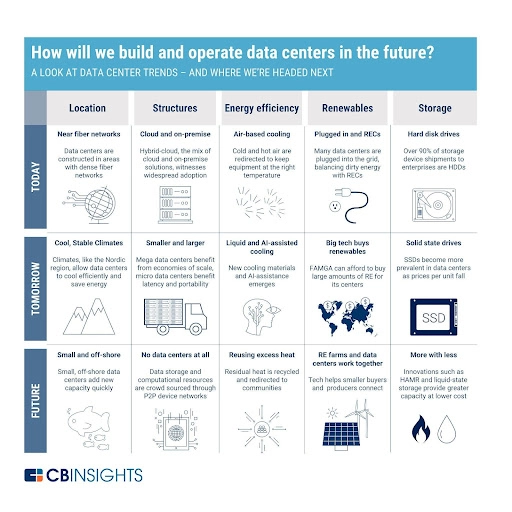Application and IT architectures have majorly transformed over the past decade as big data, cloud computing, and mobile computing disrupted distinctive business processes and applications. With modern organizations placing a high degree of emphasis on cost, speed, and scale, agile data center architectures are becoming more prevalent. The world generated 40 zettabytes (ZB) of data in 2020. That’s 1.7 MB of data per second for each person on the planet! While this surge in data generation can be attributed to the Covid-19 pandemic, it is also part of a wider, global trend for data consumption that shows no signs of slowing down. Data creation will have grown to more than 180 ZB by 2025, and the storage of this data will grow at a CAGR of around 20% during the same period. To keep pace with this exponential growth, it becomes vital for data center services to expand and grow swiftly.
Contents
Why are agile data centers required?
The number of mobile users and the proliferation of “smart” equipment over the last decade have witnessed a significant increase. Devices of varying types, from mobile phones, tablets, and laptops to gaming consoles and wearables, are used to capture valuable consumer data today. Companies need to attain, process, and promptly analyze this data to keep up with their competitors. This “need for speed” causes issues for the over-taxed data centers and leads to a mandate for faster deployment times. Agile data centers are leveraged to assimilate information at a faster rate and compensate for this prioritization of speed and services. Such data center solutions help companies create custom data center stacks, with both hardware and software, at their own pace, using their existing investments. Agile is a time-tested methodology used in IT organizations to build software or manage processes more effectively.
Agile data centers help meet the needs of today and tomorrow

Figure 2: Here’s a look at data centre trends and where we are headed next.
Image Source: cbinsights.com
With the growth in network usage, a data center has to scale to accommodate the increased network traffic with visibility of what is going on without compromising sustainability, manageability, and scalability. Companies are gradually moving beyond monolithic applications and adopting an agile IT approach for deploying applications in smaller steps to respond to rapidly evolving requirements. The modern application design favors virtualised workloads, like virtual machines and containers, when supporting rapid capacity shifts over time on a smaller set of physical servers. Traditional hierarchical data center network designs are not adequately suited to support such applications.
Troubleshooting and Analytics
On average, the time required to identify and resolve an issue related to a data center can vary depending on the complexity and severity of the problem. However, it is important to note that troubleshooting data center issues can often take longer than desired. Various factors, such as the nature of the issue, the availability of skilled network engineers, the efficiency of management methods, and the tools utilised, can impact the overall time taken to resolve the problem. Organizations strive to minimize this time to ensure smooth operations and avoid disruptions to data center services and future integrations. If the answer is “longer than it should,” then you must know that you are not alone in the situation. Too much time spent troubleshooting data center issues may hinder you from delivering good data center services and hurt both existing and future integrations.
If there is high pressure on network engineers to find the problem, traditional management methods like SNMP and CLI polling have certain limitations regarding efficiency and scalability. Tooling is pretty important here. A robust solution must include a range of telemetry collection methods, including asynchronous push models that can scale beyond traditional polling. Correlating multiple data sources into meaningful status information is also a vital requirement, as it allows the operator to identify and reach issues much more swiftly than traditional approaches. The tool must include ML technology and built-in advanced algorithms for establishing operational benchmarks, performing proactive corrective actions, and determining anomalies on its own.
Hallmarks of future-ready data center networking
Data center networks need to match the needs of increased bandwidth consumption and move data easily between data centers so that it can be accessed from almost any place. To meet these networking needs, companies must not limit the speed of innovation. As the complexity and scale of networks grow, companies can no longer view performance, availability, or the ability to innovate within silos of responsibility. There has to be a holistic evaluation of both software and hardware.
With network speeds now reaching terabits, innovation at the silicon level has become critical to allowing more agile and efficient networks without sacrificing performance or security. Here are a few design considerations providers of data center services have to embrace to meet contemporary requirements of agility and future-proof their business:
- Automation, analytics, and telemetry: Enterprises with limited talent and resources must do more with less. Therefore, telemetry and accompanying analytics have become vital to providing improved visibility into network security and performance, offering actionable insights derived from improved visibility, and enabling automation that ensures network health and prevents performance degradation.
- Latency: Data centers should have lower latency, owing to the greater level of east-west communication in contemporary, flatter networks. Data centers today run distributed, cloud-native, micro-service-based apps and AI/ML workloads. The distributed nature of these micro-service components implies that latency is an important factor that affects performance.
- Programmability: With the need to become more agile, programmable data planes for network switches have become quite vital. While it may take a couple of years just to “respin” switch silicon for a new function, programmable switch ASICs entirely eradicate the need to respin. This allows operators to effectively future-proof a data center and adapt to any changes in a rapid manner while also gaining peace of mind that they can stay competitive in any market conditions.
- Improved efficiency and power: Data centers can support superior bandwidth while reducing their environmental impact and carbon footprint with greater power efficiency. The network switches that data center operators have adopted progressively have shown dramatic power efficiency improvements in regard to watt per terabit within the same size envelope.
- Multi-sourcing strategy for networking: The world has witnessed major shortages in semiconductor components in recent years. Multiple supply chains can eventually lead to improved products, faster innovation, and lower expenses. Even though networking has not embraced multi-sourcing historically, it is time to rethink that paradigm.
In conclusion, data centers play a crucial role in supporting modern businesses across various industries. As big data applications and digital transformation continue to reshape the business landscape, organizations need to prioritise the development of agile and future-ready data centers. By embracing modern design principles and focusing on key hallmarks such as automation, analytics, programmability, and improved efficiency, businesses can ensure their data centers are equipped to meet evolving demands.
Future-proofing data centers through sustained improvement in performance and efficiencies is essential, considering the criticality of data center services and the ever-evolving technology landscape. By continually emphasising processes and initiatives that enhance agility and resilience, organisations can stay ahead of the rapid changes in the industry.
A well-designed and optimised data center provides core support for various aspects of computation, network connectivity, and data storage. It serves as a powerhouse for running critical business operations and enables organisations to harness the full potential of their data. As businesses increasingly rely on data-driven decision-making, having a robust and future-ready data center infrastructure becomes a strategic advantage.
To stay competitive and maximise business velocity, it is imperative for organisations to recognise the importance of data centers, invest in their development, and adapt to emerging technologies and trends. By doing so, they can position themselves for success in the digital era and leverage the power of data to drive innovation, efficiency, and growth.
Frequently Asked Questions
The necessary elements for building an agile data center typically include:
- Data center modernisation: Upgrading and modernizing the infrastructure, hardware, and software components of the data center to improve performance, scalability, and efficiency.
- Introducing speed: Implementing technologies and practices that enable faster data processing, network speeds, and application delivery within the data center environment.
- Executing Quality of Service (QoS): Prioritizing and managing network resources to ensure consistent and reliable performance for critical applications and services.
- Implementing disaster recovery: Establishing robust disaster recovery mechanisms and backup systems to minimize downtime and ensure business continuity in the event of a data center outage or disaster.
- Applying predictive data analytics: Leveraging advanced analytics and machine learning techniques to analyze data center performance, anticipate potential issues, and optimize resource allocation for improved efficiency and proactive problem-solving. The integration of storage and automation intelligence, along with effective QoS implementation and advanced analytics, can contribute to the development of a highly scalable and virtualized infrastructure for enterprises, reducing the need for dedicated storage personnel and enhancing overall agility.
The four major types of data centers that organizations use for housing critical data and applications are:
- Enterprise data centers
- Colocation data centers
- Cloud data centers
- Managed services data centers














